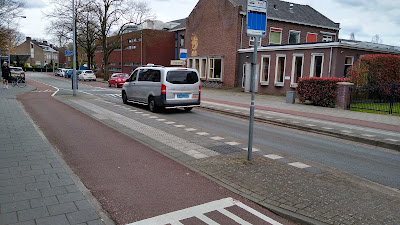I like collecting traffic engineering curiosities and the Netherlands can always be relied on for providing them; so after refuelling near the Hovenring, we headed into the edge of Veldhoven to tick something else off my list.
It had been a long day of travelling by train and cycle, but we pushed on and cycled just five minutes into the edge of the town that essentially merges into Eindhoven in search of a curious double floating bus stop.
It didn't take long to find it on Blaarthemseweg (above) and yes, it was an odd thing to see, but what made it odder was that it was on a street which really had too much traffic and where cycling was only "protected" by painted lanes.
The location was on a much longer distributor style which runs parallel to a main through route, both of which run to the town centre. The route the bus stops are on is residential, quite suburban and although traffic calmed, it felt more like a British rat-run that a quiet Dutch street.
The bus route using the street is the number 14 between the centres of Eindhoven and Veldhoven which runs every 30 minutes in each direction and give that none of the other stops are floating, it seems really odd to do so here. So why? If it was for safety then maybe all of the other bus stops would have been treated, but for two buses an hour the risk of conflict with cycle traffic is practically non-existent.
Well I think it performs two functions, but before I get to those, I think we have some clues to help guide us. The double bus stop is outside Zeelsterhof Primary School which you can see in the photograph above and also a block of apartments on the other side of the street which appears to be a sheltered and supported living complex for older people - two demographics which might use the bus.
The first function is traffic calming. If we forget the buses completely, the layout is give-and-take single lane working and as there is no indication on who has priority, drivers have to negotiate with each other. The lane is narrow and there is a speed hump. Although not formally marked (at least with any tactile indicators), the speed hump provides a flat surface for crossing the road.
It's worth having a look at the layout in 2008 (above) because the layout was still give and take, but the central area was one long speed hump which helps me conclude that this was traffic calming by the school foremost, with the bus layout coming later (it looks very new in 2016), although there was still a bus route here in 2008.
The cycle bypasses are consistent with traffic calming elsewhere in the area because those cycling can continue in safety and don't have to get into having to interact with drivers in situations where drivers will try and assert priority. I found the design layout in my 1998 copy of "Recommendations for Traffic Provisions in Built-up Areas" a Dutch design manual that has lots of interesting things in it.
Maybe there was an upgrade of the bus stop facilities along the route and the designer took the opportunity to reuse the extant piece of traffic calming to provide a pair of stops to serve the school and the apartments and in doing so retained the bypasses for cycling because that's the standard approach from a traffic calming point of view.
Of course, I hadn't realised or thought about all of this until I sat down to write this post, but you can't help be impressed at the subtle creativity of Dutch engineers, although in fairness, the whole thing could be rendered obsolete if the area is ever redesigned at the network level with bus gates that stop driving through, but retain bus access. Maybe that will be the next iteration that allows the clutter to be taken away.
Oh and one other thing, given a similar context, there is absolutely no reason why we could not provide a layout like this in the UK. I'll leave you with a clip of drivers using this piece of curious Dutch traffic engineering.







Presumably the idea is that when the bus is at the stop no motor vehicle can overtake so passengers can freely and safely cross the road.
ReplyDeleteThat's potentially another positive, although I am not sure if buses would be there long enough for protection, but maybe.
Delete